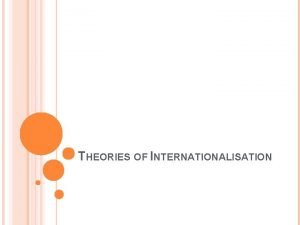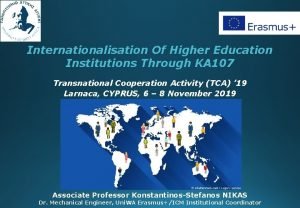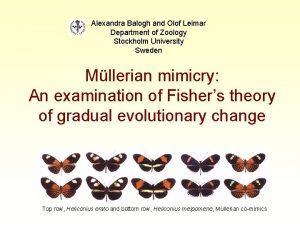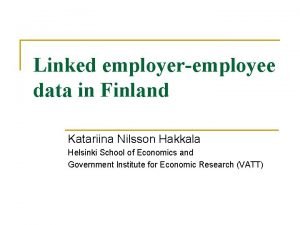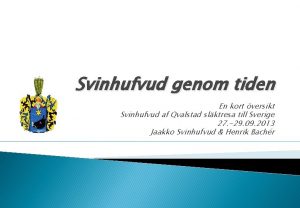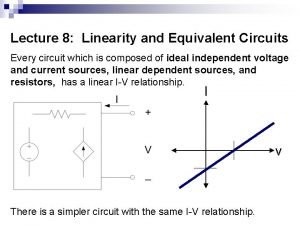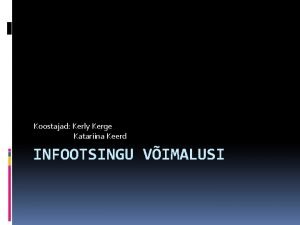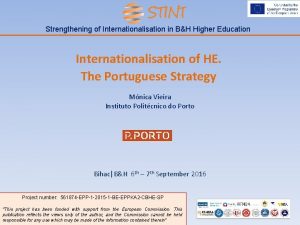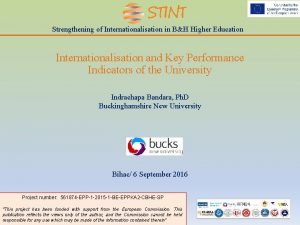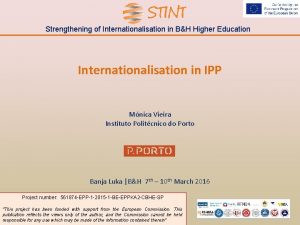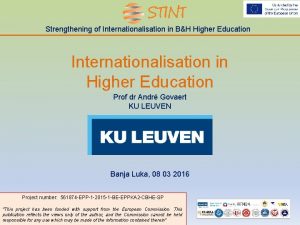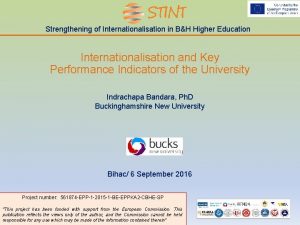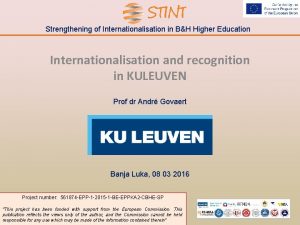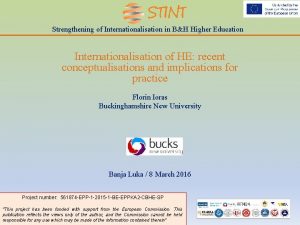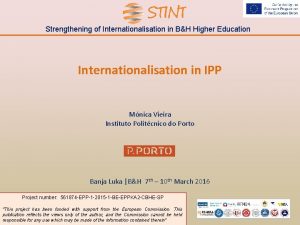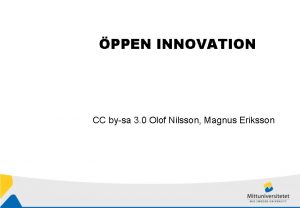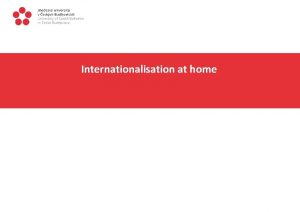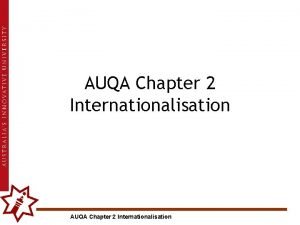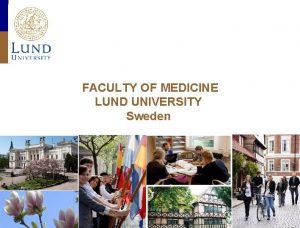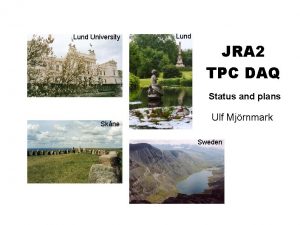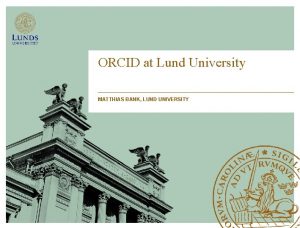Internationalisation of Higher Education Jan Olof Nilsson Lund






























- Slides: 30

Internationalisation of Higher Education Jan Olof Nilsson Lund University Dep. of Sociology Jan-olof. nilsson@soc. lu. se

• Are we at the beginning of a future in which we are, in the words of Clark Kerr, on our way again to the "universalism of learning: the universaluniversity world", the revival of the cosmopolitan university of the medieval times, but within the context of a new modern world and a new age, the information age, in which society, economy and knowledge are part of a global environment, a mix of local and global influences? (de Wit, 1998)

• Erasmus of Rotterdam, who has become a symbol for the medieval student, a Wandering student (Wanderstudent), travelling between Holland, France, Italy, England. . • A lingua franca - Latin

• Universities have always been affected by international trends and to a certain degree operated within a broader international community of academic institutions, scholars, and research. Yet, 21 st century realities have magnified the importance of the global context. The rise of English as the dominant language of scientific communication is unprecedented since Latin dominated the academy in medieval Europe. Information and communications technologies have created a universal means of instantaneous contact and simplified scientific communication • Old Universities in New Environments – New Technology and Internationalisation Processes in Higher Education. (Nilsson&Nilsson 2004)

• After the medieval era the universities become more administrative and economic strategic units in construction of national identities in the construction of a nation state. • But in later part of the 20 th century universities again become more internationalised, quite often with support from the state. Interationalisation become even an important interest of the nation.

• Universities started in the later part of th 20 th century to develop their own strategies for internationalisation. • They showed very proud how many international agreements they have all over the world – both in research and education. Delegation from universities traveled all over the world, had dinners, shake hands, took photos and signed an agreement. • The cost for travelling in the university budget increased every year. The message: Internationalise or die! The importance of ranking system.

Definition • Activities in higher education leading to an intercultural dimension, including international students, internationalisation of curricula, student/teacher exchange • Competence, knowledge, attitudes and values important in a world wide market – about competition. • Create an environment and atmosphere supporting international- and intercultural perspectives and initiatives. • The process of integrating an international, intercultural or global dimension into the purpose, functions or delivery of post-secondary education. (Knight, 2003) • The intentional process of integrating an international, intercultural or global dimension into the purpose, functions and delivery of post -secondary education, in order to enhance the quality of education and research for all students and staff, and to make a meaningful contribution to society. (De Wit, H. , 2015)

• Process. The term process is deliberately used to convey that internationalization is an ongoing and continuing effort. • International, intercultural, and global dimension. These terms are intentionally used as a triad, as together they reflect the breadth of internationalization. International is used in the sense of relationships between and among nations, cultures, or countries. But we know that internationalisation is also about relating to the diversity of cultures that exists within countries, communities, and institutions, and so intercultural is used to address the aspects of internationalization at home.

• Integrating. The concept of integration is specifically used to denote the process of infusing or embedding the international and intercultural dimension into policies and programs to ensure that the international dimension remains central, not marginal, and is sustainable.

• Purpose, function, and delivery. These three concepts have been carefully chosen and are meant to be used together. Purpose refers to the overall role and objectives that postsecondary education has for a country/region or, more specifically, the mission or mandate of an individual institution.

Approaches • 1. Activity perspective. It focuses on higher education activities that promote an intercultural dimension, including the presence of international students, curriculum and student/faculty exchange. • 2. Competency perspective. It emphasizes the development of skills, knowledge, attitudes and values that are important for one to compete in the global marketplace. • 3. Ethos perspective. It emphasizes creating a culture or climate that values and supports intercultural/international perspectives and initiatives. • 4. Process perspective. It stresses the integration of an international and intercultural dimension into teaching, research, and service through a combination of activities, policies and procedures.

Rationales • Social/cultural. National cultural identity, Intercultural understanding, Citizenship development • Knowledge in foreign language (English) • Knowledge about other societies and cultures- Cultural global competence. • Incoming students knowledge about your country. Incoming students will be ambassadors for your country and your university. • Alumni

• Political. Diplomatic investment. Future political and economic relations – future leaders in other countries, and business contacts. But also ideas about ideology export – human rights etc. • Alumni

Economic growth and competitiveness. Labour market, Financial incentives Global business – international student an investment – network. Education as a commodity – China, India. Wander. Universities.

Academic. International dimension to research and teaching Extension of academic horizon Institution building. Profile and status Enhancement of quality - International academic standards Attract top students and professors by courses and research collaboration in English. International publications Ranking

Reaserch • • • Kehm&Teichler • Mobility of students and academic staff. • Mutual influences of higher education systems on each other. • Internationalisation of the substance of teaching, learning, and research. • Institutional strategies of internationalisation. • Knowledge transfer. • Cooperation and competition. • National and supranational policies as regarding the international dimension of higher education. Reaserch more normative (why you should internationalise) and texts written also by adminstrative staff

International Association of Universities (IAU) • Largest network for higher education institutions. A survey 2009, published 2010. Answers from 745 higher education institutions in 115 countries. Also includes almost 20 national institutions related to higher education.





Opportunity to Study Outside One’s Own Country as % of overall enrolment N=745

2014 (2015) • Internationalization of Higher Education – Growing expectations, fundamental values • Published on April 1 2014, the IAU 4 th Global Survey reports analyses responses from 1, 336 higher education institutions in 131 different countries. The report presents the largest and most geographically comprehensive collection of primary data on internationalization of higher education available today. • Some highlights of the report include: • Institutions world-wide are focusing on internationalization. Over half of the respondents report that their institution has an internationalization policy/strategy, and 22% report that one is in preparation. Just over 15% indicate that internationalization forms part of the overall institutional strategy.

• Student mobility and international research collaboration are the highest-priority internationalization activities within institutions • Student knowledge of international issues is the most significant expected benefit of internationalization. This is the same finding as in the IAU 3 rd Global Survey (2009) and the 2 nd Global Survey (2005). • International opportunities being available only to students with financial resources, was ranked by respondents as the most significant potential risk of internationalization for institutions while the most significant societal risk is noted as commodification/commercialization of education

• In the majority of regions, respondents indicated that their geographic focus for internationalization was on their own region. Europe is also a strong focus for most regions. • Limited funding is the major internal and external obstacle to advancing internationalization. This finding was also true in the two previous IAU Global Surveys. • Respondent institutions report that they seek to promote values of equity and sharing of benefits through their internationalization strategy and activities.

• Jane Knight (2011: 14) writes about “Five Myths About Internationalization”. According to her, these myths are: • Myth one: Foreign students as internationalization agents: “more foreign students on campus will produce more internationalized institutional culture and curriculum”. • Myth two: International reputation as a proxy for quality: “the more international a university is (. . . ) the better its reputation”.

• Myth three: International institutional agreements: “the greater number of international agreements or network memberships a university has the more prestigious and attractive it is”. • Myth four: International accreditation: “the more international accreditation stars an institution has, the more internationalized it is and ergo the better it is”. • Myth five: Global branding: “an international marketing scheme is the equivalent of an internationalization plan”.

• I (De Wit, 2011) write about misconceptions and challenges for higher education, and I identify nine misconceptions, two of which are similar to Jane Knight’s myths one and three. These misconceptions are: • Internationalisation is similar to teaching in English. • Internationalisation is similar to studying abroad. • Internationalisation is similar to teaching an international subject.

• Internationalisation means having many international students (see Knight’s myth one). • Internationalisation can be implemented successfully with only a few international students in the classroom. • Intercultural and international competencies do not necessarily have to be assessed as such. • The more agreements an institution has, the more international it is (see Knight’s myth three).

• Higher education is international by its very nature. • Internationalisation is an objective in itself.
 Jan nilsson lund
Jan nilsson lund Per woxler
Per woxler Tca model of internationalisation
Tca model of internationalisation Internationalisation def
Internationalisation def Internationalisation def
Internationalisation def Olof leimar
Olof leimar Drivers of globalization
Drivers of globalization Olof linden
Olof linden Olof van der linden
Olof van der linden Olof person
Olof person Mirjam nilsson contoso
Mirjam nilsson contoso Flora berggren
Flora berggren Contoso pharmaceuticals
Contoso pharmaceuticals [email protected]
[email protected] Quis
Quis Prof paul nilsson
Prof paul nilsson Mirjam nilsson
Mirjam nilsson Mirjam nilsson
Mirjam nilsson Kristy nilsson
Kristy nilsson Katariina nilsson
Katariina nilsson James w nilsson
James w nilsson Ira waluyo
Ira waluyo Mirjam nilsson
Mirjam nilsson Jaakko svinhufvud
Jaakko svinhufvud Thevenin and norton examples
Thevenin and norton examples Alexander martensson
Alexander martensson Herencia cualitativa y cuantitativa
Herencia cualitativa y cuantitativa Plb631
Plb631 Database selection criteria
Database selection criteria Marcus nilsson chef
Marcus nilsson chef Katariina nilsson hakkala
Katariina nilsson hakkala


